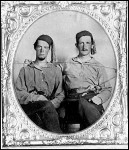

The photograph gives us seemingly direct access to the past -- we can see for ourselves what used to be. In this sense, photographs not only document history but transform our historical consciousness. As Alan Trachtenberg wrote, "To hold before one's eyes a vintage albumen print made at Gettysburg or Antietam or Charleston is to realize the truth of Paul Valery's observation that, once the camera appeared, our sense of what suffices as a historical account was altered forever." Trachtenberg, , 78-79
We can look at Lincoln looking at tombstones. We can see for ourselves
the Civil War.

But even as photographs let us glimpse the past, old photgraphs can themselves be physical tokens of the past. Reach out and touch the cracked surface of a hundred and fifty year old daguerreotype, and you physically touch history.
Fewer and fewer Americans possess objects that have a patina, old furniture, grandparents' pots and pans -- the used things, warm with generations of human touch. . . . Instead we have our paper phantoms, transistorized landscapes. A featherweight portrable museum.
As objects with a patina, embodiments of the old, Sontag
argues that photographs The daguerreotype's velvet case, the tintype's metal solidity --
these photographs are tactile objects. The web lets us link everywhere
and all at once -- but how can one preserve this tactile link to the past on
the Web?
Maintained by
jmnookin@bug.village.virginia.edu
![]() Picturing Truth
Picturing Truth
![]() Spirit
Trouts
Spirit
Trouts
URL: http://www2.iath.virginia.edu/ensp982/mnookin/past.html
Last Modified: Tuesday, 26-Feb-2008 14:47:52 EST